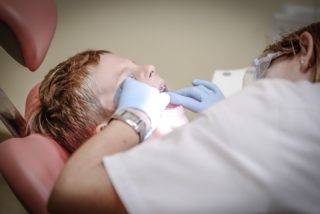LASERS mean Light Amplification by Stimulated Emission of Radiation.
 All lasers work by delivering energy in form of light. When used in dental procedures, lasers act as a cutting instrument or as a source of heat to produce desires effect. The use of laser technology and its advancements in the field of medicine and dentistry is playing a major role in patient care and well-being.
All lasers work by delivering energy in form of light. When used in dental procedures, lasers act as a cutting instrument or as a source of heat to produce desires effect. The use of laser technology and its advancements in the field of medicine and dentistry is playing a major role in patient care and well-being.
Uses of Lasers :
- Gum Diseases – Lasers used as an adjunct to meticulous root planing, mechanical or chemical curettage (i.e., the intentional removal of the epithelial lining of the sulcus) offers consistent benefit beyond scaling and root planing alone with respect to gain of the periodontal attachment. Laser assisted curettage significantly improves outcomes in mild to moderate periodontitis. The treatment is not invasive and comfortable to the patients. The beneficial effects of these lasers are due to the bacterial properties particularly against periodontal pathogens.
- Biopsy Or Lesion Removal – The lasers are placed in cutting or focused mode, held perpendicular to the tissue and follow the surgical outline. When laser light interact with the soft tissue, there is vaporization of intra and extracellular water content resulting in ablation or removal of biological tissue. In addition, there are specific soft tissue indications for the clinical use of lasers, including gingival depigmentation, gingivectomy/gingivoplasty, operculectomy, sulcus debridement, pre-impression sulcular retraction, laser assisted new attachment procedures, removal of granulation tissue
- Tooth Whitening – Dental lasers when combined with bleaching agents can produce desired tooth whitening. The light activates the gel; breaking it down into water and a radical (compound constituent). Once the gel is in this state, the radical appends itself to stain molecules. This causes the stains to weaken, allowing oxygen to reach and whiten the enamel. Lasers can enhance bleaching by photo-oxidation of colored molecules in the teeth or by interaction with the components of the bleaching gel through photochemical reactions. The result is a visually whitened tooth surface
- Surgical Procedures – Bone Surgery and Osseous Crown Lengthening, frenectomy, and other surgical procedures.it makes most surgical procedures painless and reduces bleeding.
- Removal of Dental Caries – Laser systems can be used for effective caries removal and cavity preparation without significant thermal effects, collateral damage to tooth structure, or patient discomfort.
